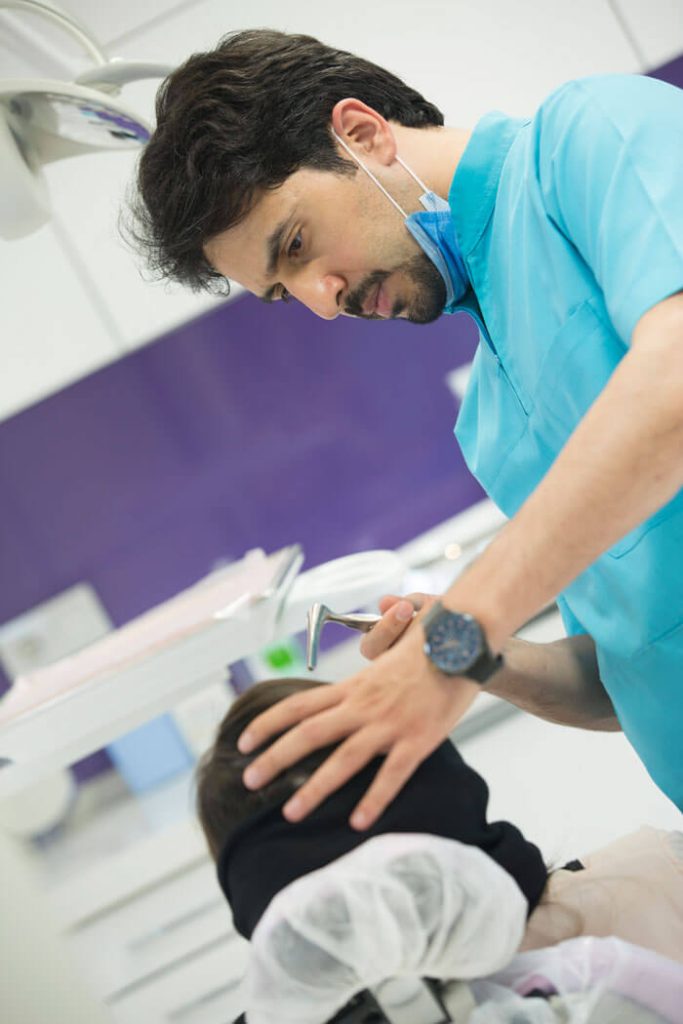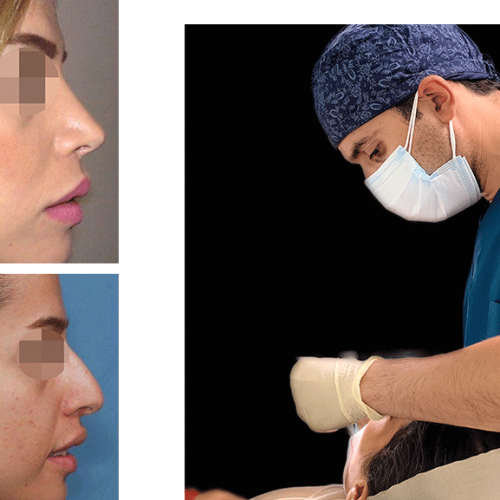Rhinoplasty | Nasal Plastic Surgery
Rhinoplasty, also referred to as “nasal surgery,” is a surgical procedure designed to modify the form, structure, size, or proportions of the nose. Rhinoplasty, or nasal reshaping, ranks among the most widely sought-after and prevalent plastic surgery interventions globally, with a heightened demand observed particularly among Iranians.

A significant number of individuals express dissatisfaction with the shape or size of their nasal structure. Given the nose’s fundamental role in establishing facial symmetry and harmony, patients strive to achieve enhanced aesthetic balance and proportion among their facial features. Often, they elect to undergo nose reshaping or nasal plastic surgery to attain a more aesthetically pleasing facial triangle. Some individuals seek alterations to the nasal shape and contour that do not exhibit any marked association with other facial components. Of course, everyone wishes to have a small, natural-looking nose with an elevated bridge. However, the primary consideration lies in achieving proportional harmony among the various facial elements, which constitutes the essence of beauty.
[read more]
Occasionally, cosmetic concerns may relate more closely to the positioning of the chin or jaw, yet patients tend to concentrate their dissatisfaction on the nose. Our objective is to perform natural and proportionate nasal surgery, taking into account each patient’s distinctive facial characteristics while preserving unimpeded respiratory pathways.
The shape of the face, facial contours, the distance between the nose and lips, interocular distance, and other influential factors play crucial roles in determining the size and form of the patient’s nose. Above all, the preservation of proper breathing and unobstructed respiratory passages assumes paramount importance, necessitating that cosmetic surgery aligns with the preservation of patients’ health and optimal respiration.
Analogous to other cosmetic procedures, rhinoplasty is a surgical intervention in which the outcomes cannot be guaranteed or replicated precisely from a predefined model, owing to the anatomical, structural, and aesthetic distinctiveness inherent in each individual.
[/read]

Contact with a Cosmetic Nose Surgeon
If you are seeking rhinoplasty or functional nasal plastic surgery with preservation of the nasal function and a desire for natural facial and nasal aesthetics, we encourage you to schedule a visit and consultation with Dr. Alireza Modaresi, a distinguished specialist in maxillofacial surgery (nasal plastic surgery).
Lorem ipsum dolor sit amet, consectetur adipiscing elit. Ut elit tellus, luctus nec ullamcorper mattis, pulvinar dapibus leo.
- Saturdays: 14:00 to 20:00 - Punak clinic
- Sundays: 14:00 to 20:00 - Shariati clinic
- Mondays: 14:00 to 20:00 - Punak clinic
- Thursday: 14:00 to 20:00 - Saveh clinic

The surgeon can adjust and reduce the central nasal structure, known as the septum, to help reduce the size of the nasal tip and overall length of the nose. Concurrently, correcting the cartilage of the nasal tip also contributes to the shaping and length reduction of the nose.
[read more]
In cases where appropriate, your maxillofacial surgeon can diminish the width and breadth of the nose by manipulating and repositioning the lateral nasal bone. This surgical approach yields a refined and more slender nasal contour.
Occasionally, patients who have undergone multiple surgeries may present with insufficient cartilage tissue or compromised cartilage size and form. In such instances, the surgeon can employ cartilage grafts or, in some cases, consider the utilization of silicone implants in the affected region.
Subsequent to the procedure, internal nasal tampons are carefully placed, while external splinting is employed to ensure optimal support and stabilization. Typically, the nasal splint remains in place for a duration of seven to ten days, serving as a crucial protective measure against potential trauma, alleviating pressure on the nasal structure, reducing swelling, and overall safeguarding the surgical outcome.
[/read]
Post-Rhinoplasty Instructions | Nasal Plastic Surgery
1. It is advisable to rest for 48 hours following the surgery.
2. Sleep in supine position with your head elevated and use multiple pillows to keep your head higher than your neck.
3. Take care of the nasal cast or splint.
4. Showering is permissible after the surgery as long as the face doesn’t get completely wet, the patient is in a balanced state, and not experiencing dizziness. However, complete bathing should not be done until the external splint is removed, as getting wet and the splint remaining damp can compromise its functionality and potentially affect the shape of the nasal cavities and blade.
5. Washing the face should be done in a way that water does not directly contact the nose. The rest of the face should be washed with caution.
6. The use of cold compresses on the nose and under the eyes is mandatory for 24 hours after the surgery. This helps control swelling and bruising. Apply the compress for twenty minutes at a time and remove for a quarter. Repeat this process until bedtime.
7. Consuming soft and liquid foods such as meat broth and cool fluids is necessary for the first 24 hours after the surgery.
8. Avoid keeping your head down and engaging in physical activities for 72 hours after the nasal surgery.
9. Avoid engaging in strenuous exercises that exert pressure on the head and face area for two months. However, light or gentle exercises are permissible from the third week after the surgery.
10. Prevent nasal aerobic changes, and if necessary, sneeze or cough with an open mouth.
[read more]
11. Avoid blowing your nose or applying pressure to the nose.
12. Avoid facial expressions and movements that strain the face while laughing or talking.
13. Stay hydrated by consuming ample fluids. Pineapple juice, celery juice, etc., can be beneficial. It is best to avoid excessive salt intake during the first few days and use it sparingly for one to two weeks.
14. If you wear glasses, it is recommended to consult with your ophthalmologist before the surgery to consider using prescription lenses during this period.
15. Pain and inflammation are normal for up to three days. However, patients usually do not experience severe pain or inflammation after the surgery. It is important to follow the prescribed painkillers, medications, and drops to manage pain and inflammation.
16. Nasal and facial swelling and bruising increase for up to three days after the surgery and gradually decrease after that period. Typically, bruising disappears within one to two weeks.
17. Nasal swelling gradually subsides after two weeks of removing the external splint.
18. Use nasal drops precisely to prevent congestion and nasal blockage.
19. After the surgeon removes the splint, apply tape to the nose in the correct and proper manner taught by the surgeon. Apply two layers for up to three weeks, followed by one layer for two to three weeks, and then only at nights for the remaining weeks. In total, the taping process should be followed according to the surgeon’s instructions for approximately two months.
20. Avoid applying any pressure or impact to the nose after cosmetic nose surgery.
21. An instructional video will assist you in learning how to tape the nose on your own.
[/read]
Nasal polyps are soft tissue masses inside the nasal lining that usually do not cause pain or noticeable symptoms. However, if left untreated, they can grow larger and obstruct the patient’s airways, causing breathing difficulties or block it.
The symptoms of nasal polyps are typically similar to those of a common cold. However, a cold typically resolves within a few days, whereas nasal polyps do not improve unless treated. It is possible for the polyps to affect the patient’s sinus cavities, leading to symptoms of sinusitis.
[read more]
When these issues arise, you are usually prescribed steroid drops or sprays to alleviate symptoms or shrink the polyps. Alternatively, you may be prescribed oral steroids and medications. However, it is generally recommended that if your polyps are large and depending on the opinion of a maxillofacial or otolaryngologist surgeon, you consider surgery, as nasal drops and sprays have no significant effect based on the size of the polyps.
If your nose has an appropriate shape and appearance and the need for surgery is solely to address the polyps, you should consult with ear, nose, and throat specialists. However, if you are considering rhinoplasty for cosmetic purposes and have been suffering from nasal polyps for a long time, it is important to know that a maxillofacial surgeon can perform both the cosmetic nose surgery (rhinoplasty) and the polyp removal surgery simultaneously, so that your nose will not only have a beautiful appearance but also improve your health.
[/read]


- Snoring
- Nasal obstruction
- Runny nose
- Headaches
- Nosebleeds
- Throat dryness
- Decreased sense of smell or taste